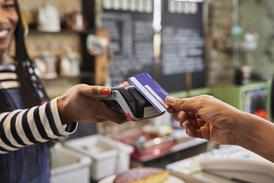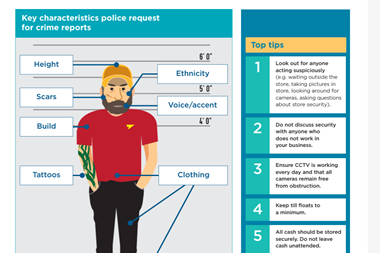Based on the market square in the bustling town of Richmond, North Yorkshire, Peter Warne’s convenience store is never short of customers. Named after Peter’s father and former owner of the store, Ken, the shop has been around for decades. But because it’s based in the town centre, which plays host to an eclectic mix of shoppers, Peter has had to become more than just a top-up shop to keep his customers happy.
Alongside the household staples, Peter’s store has a secondary range of premium and local products, which he claims is as big as a normal convenience store’s primary range of products. And there’s no doubt that this is a hit with customers: “We have an unusual mix of stuff – it’s been built up on customer requests over the years,” explains Peter. “We sell more olives here than beans!”
But it’s not easy to keep everyone happy. “Catterick Garrison – one of the biggest army bases – is about three miles away, so that influences a lot of our range – we stock lots of products from Germany,” he says.
“There’s also the tourist element. They want to come here and find something that they can’t get at home,” he adds. This means that managing stock can be tricky. “With some of the more unusual items, we’re dealing with the suppliers only five or six times a year. If somebody comes in and buys a whole case of the product, then we won’t have any more of it for the next couple of months,” says Peter.
He does scan products, but doesn’t have a re-ordering system. “I’m concerned it would be too much work, so I’m apprehensive,” he says. However, he admits: “There’s a pay-off between products going out of date and not having enough supply. Stock control is a real challenge.”
in the experts' opinion:
Steve Bassett
Londis, Weymouth, Dorset
“Many retailers are reluctant to use re-ordering systems because they don’t trust computers, but they really need to embrace the technology. A re-ordering system is far more accurate than relying on instinct.
“It’s best to put your products on a re-ordering system bit by bit. Start with something easy, such as the frozen category, and work your way through the store.
“Just because you are using the system doesn’t mean you end up relinquishing all control. Your knowledge and experience will go far beyond that of a computer, so you will still have to intervene and order extra mince pies at Christmas or more ice in the summer. Also, if there is a spike in sales due to a promotion then you will have to adjust the system so that it doesn’t get confused.
“It could save hours and cut down on your stock holding. I don’t have to speak to my suppliers every month; before, I could waste an hour walking round the store with a rep instead of saving time by emailing or faxing an order. I never work 90 hours a week – let the technology do the work for you.”
Kishor Patel
Nisa Local, Houghton Regis, Bedfordshire
“Peter’s best bet is to get a system that speaks to his wholesaler. That’ll help to take care of the availability and reading of stock.
“In addition, he can add local suppliers onto the system. It can be a bit time-consuming, but once they’re there you have a record of them and you’ve got it for the rest of your life.
“Pre-ordering is also something to consider. With the Army, I expect they are pretty much using the same products on a regular basis, so Peter could put a pre-order system in place to make life easier. I give pre-order forms to some of my customers and often ask people if they mind waiting until next week for a bulk order. They are usually happy to oblige and then I either offer to send them the product or, more often than not, they agree to pick it up, which means another visit and the opportunity to generate additional sales.
“It’s a good idea for Peter to put a sign up near the more unusual products, telling customers that they can order in bulk and if there is a product that they can’t find, he will be happy to order it for them.”
Alongside the household staples, Peter’s store has a secondary range of premium and local products, which he claims is as big as a normal convenience store’s primary range of products. And there’s no doubt that this is a hit with customers: “We have an unusual mix of stuff – it’s been built up on customer requests over the years,” explains Peter. “We sell more olives here than beans!”
But it’s not easy to keep everyone happy. “Catterick Garrison – one of the biggest army bases – is about three miles away, so that influences a lot of our range – we stock lots of products from Germany,” he says.
“There’s also the tourist element. They want to come here and find something that they can’t get at home,” he adds. This means that managing stock can be tricky. “With some of the more unusual items, we’re dealing with the suppliers only five or six times a year. If somebody comes in and buys a whole case of the product, then we won’t have any more of it for the next couple of months,” says Peter.
He does scan products, but doesn’t have a re-ordering system. “I’m concerned it would be too much work, so I’m apprehensive,” he says. However, he admits: “There’s a pay-off between products going out of date and not having enough supply. Stock control is a real challenge.”
in the experts' opinion:
Steve Bassett
Londis, Weymouth, Dorset
“Many retailers are reluctant to use re-ordering systems because they don’t trust computers, but they really need to embrace the technology. A re-ordering system is far more accurate than relying on instinct.
“It’s best to put your products on a re-ordering system bit by bit. Start with something easy, such as the frozen category, and work your way through the store.
“Just because you are using the system doesn’t mean you end up relinquishing all control. Your knowledge and experience will go far beyond that of a computer, so you will still have to intervene and order extra mince pies at Christmas or more ice in the summer. Also, if there is a spike in sales due to a promotion then you will have to adjust the system so that it doesn’t get confused.
“It could save hours and cut down on your stock holding. I don’t have to speak to my suppliers every month; before, I could waste an hour walking round the store with a rep instead of saving time by emailing or faxing an order. I never work 90 hours a week – let the technology do the work for you.”
Kishor Patel
Nisa Local, Houghton Regis, Bedfordshire
“Peter’s best bet is to get a system that speaks to his wholesaler. That’ll help to take care of the availability and reading of stock.
“In addition, he can add local suppliers onto the system. It can be a bit time-consuming, but once they’re there you have a record of them and you’ve got it for the rest of your life.
“Pre-ordering is also something to consider. With the Army, I expect they are pretty much using the same products on a regular basis, so Peter could put a pre-order system in place to make life easier. I give pre-order forms to some of my customers and often ask people if they mind waiting until next week for a bulk order. They are usually happy to oblige and then I either offer to send them the product or, more often than not, they agree to pick it up, which means another visit and the opportunity to generate additional sales.
“It’s a good idea for Peter to put a sign up near the more unusual products, telling customers that they can order in bulk and if there is a product that they can’t find, he will be happy to order it for them.”


























No comments yet